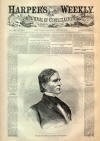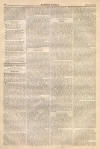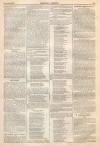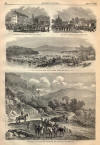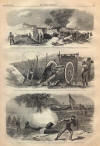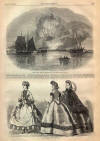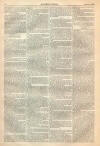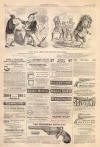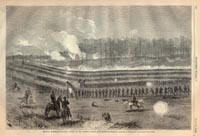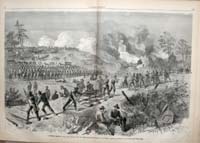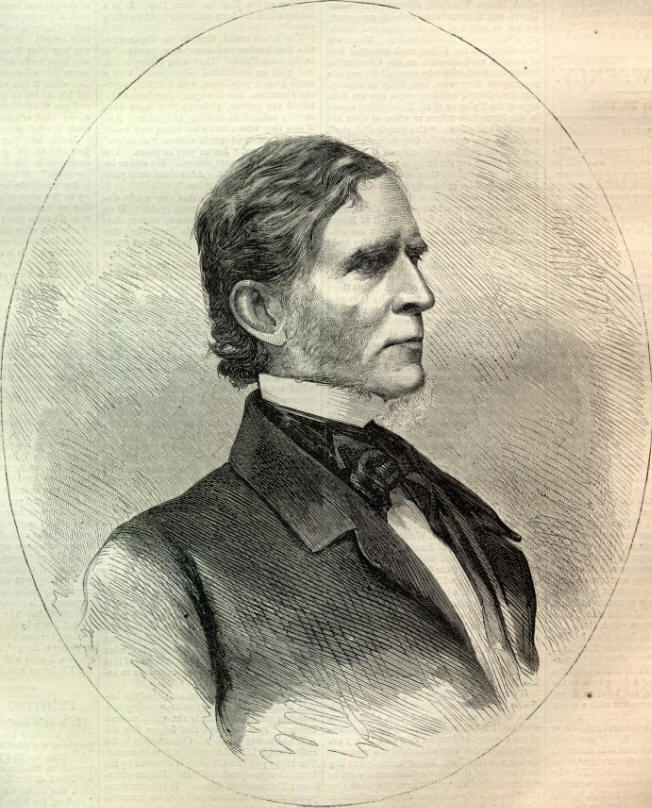|
This Site:
Civil War
Civil War Overview
Civil War 1861
Civil War 1862
Civil War 1863
Civil War 1864
Civil War 1865
Civil War Battles
Confederate Generals
Union Generals
Confederate History
Robert E. Lee
Civil War Medicine
Lincoln Assassination
Slavery
Site Search
Civil War Links
Civil War Art
Mexican War
Republic of Texas
Indians
Winslow Homer
Thomas Nast
Mathew Brady
Western Art
Civil War Gifts
Robert E. Lee Portrait
|
NEW YORK, SATURDAY, JULY 30, 1864.
$1,00 FOR FOUR MONTHS.
$3,00 PER YEAR IN ADVANCE.
Entered
according to Act of Congress, in the Year 1864, by Harper & Brothers, in the
Clerk's Office of the District Court for the Southern District of New York
WILLIAM PITT FESSENDEN.
WILLIAM PITT FESSENDEN,
the new Secretary of
the Treasury, whose portrait we give on this page,
was born at Roscowen, New Hampshire, October
16, 1806, and is therefore now fifty-eight years old.
He was a graduate of Bowdoin College, at the early
age of seventeen, and at twenty-one was admitted
to the bar. Remarkable for energy and intelligene his progress was rapid. He was
a member
of the State Legislature when only twenty-five years
of age, and was the youngest member
of that body.
His insight
into the details of Political Economy as
connected
with legislation was even thus early evidenced
in
a debate on the United States Bank, in which he won distinction. In 1840 the
Whig candidate for
Congress, and successful even beyond the
limits of a party vote ; in 1843 renominated, but declining
from a choice to pursue his profession ; in
1850 again elected, but deprived of his seat by a
mistaken return of ballots; in 1854 elected to
the Senate, where he was perhaps the ablest opponent to the Nebraska bill
; again elected in 1859, for the six years which are just expiring; and now, in
consonance with the wishes of the whole country, appointed to fill the most
difficult and the most rcsponsible
position in the Cabinet—these have been the steps by which
Mr.
FESSENDEN, for more
than a generation, has steadily risen in popular estimation and in his power to
serve his country. Not known as a man of genius, or even of uncommon brilliancy,
experienced in solid
statesmanship rather than superficial policy, he perhaps more than
any other man was fitted for
the position which he
now fills. This is no blind confidence, since
Mr.
FESSENDEN, as Chair-man
of the Senate Finance Committee, has given a foretaste of his greatness as a
financier.
IN THE
TRENCHES.
WE give
on page 485
three illustrations of the
siege of Petersburg, relating chiefly to the operations of our artillery.
Captain ASHBY'S battery, Third New York Artillery, the subject of
one of these sketches, is
close to the enemy's
line, which it incessantly annoys with troublesome messengers,
stirring up the rebel infantry and distracting the aim of
sharp-shooters, which, in turn, do their best to kill our gunners.
Another sketch exhibits
a method by which the gunners protect themselves
against sharpshooters. This is effected by means of
mantelets,
which are really nothing
more nor less than ropemats, heavily constructed,
made to cover the embrasures,
and having an aperture
through which the gun's
muzzle is thrust.
The
Cohorns, which are the subject of the remaining sketch, are small brass
mortars, which have proved of great service in demoralizing the enemy in his
rifle-pits in places where
the
lines
are so close
as
to afford no available positions for light artillery. The Cohorns are fired over
our own soldiers at a great
elevation, dropping shells with effect upon the unseen defenders of the
rebel works.
WILSON'S RAID IN VIRGINIA.
GENERAL
WILSON'S raid, which we illustrate on
pages 488 and 489, dealt a serious blow against
ROBERT E. LEE'S
lines
of communications with the
South. This illustration affords the reader a vivid, and at the same time
a correct, impression of the manner
in which an extensive cavalry
raid is carried. So far from being an irregular proceeding, a great raid
is now as well organized as any other movement of the army ; each man has
his work to do, and one stage
of operations succeeds another as regularly as
the evolutions on a parade-ground. WILSON'S raid resulted in a
destruction of sixty miles of railroad,
a destruction in which the Danville and the South-side road shared about
equally. General WILSON
reported that it would take the
rebels forty days, even if they had the material at hand to repair the loss. The
expedition had some difficulty in returning; but it succeeded finally in eluding
the enemy, getting back to our lines with a loss of twelve
cannon and between
750 and 1000 men.
THE REBEL INVASION OF MARYLAND.
THE
rebel raid in Maryland (illustrated on
page
484), which a few days ago was the exciting theme
of conversation, has vanished, leaving behind as the
traces of its devastation desolated homes, empty roosts and stables, and broken
communications. The Government has not been directly a great sufferer,
although
a
considerable amount of commissary
and ordnance stores were captured at
Martinsburg.
For the most part the burden of loss has fallen upon private citizens.
The illustrations which we give
refer to a few out of the many scenes connected with this raid; they need
no detailed description. The Chesapeake and Ohio Canal runs along the line of
the Potomac from Georgetown to Cumberland, where it terminates; it runs
side by side with the Baltimore and Ohio railroad. The cost of the work was over
twenty-two millions. The damage which the rebels have done will be easily
repaired. It is an occasion for
regret that they have been able to carry away so much plunder.
ON
page 492 we give a sketch illustrating
SHERMAN'S
advance. The action represented in the cut
was only a part of a grand
movement. The fighting was
done chiefly by portions of
JEFFERSON C. DAVIS'S and
NEWTON'S
divisions, of the Fourteenth
and Fourth Army Corps
respectively, who had orders
to break the Confederate
centre, if possible. At the
same time an attack was made
on the right and left by
LOGAN and
BLAIR. The
attack on the centre, though
gallantly executed, was
unsuccessful. NEWTON'S
division attacked on the
right, DAVIS'S on the left. General HARKER,
one of the best-beloved men
in the army, a brave soldier and
a true patriot, was killed.
Colonel DANIEL McCook
was badly wounded, and
Colonel MITCHELL
slightly.
THE FIRE IN BROOKLYN.
THE great fire which took place on Friday, July 15, in Brooklyn, and which we
illustrate on page 493, is the most destructive which has occurred in that city
for many years. The fire, occasioned by carelessness, broke out in one of
the two great warehouses of Messrs. SCHLENCK &
RUTHERFORD, at the foot of Joralemon Street at 12 1/2 o'clock, while the
workmen were away at dinner. The two structures, partly of brick and partly of
wood, were known as the Free and the Bonded warehouses respectively, extending
300 feet on the waterline and 200 feet deep. They were used for storage, and
contained a great quantity of saltpetre, together with sugar,
molasses, hides, and guano. As soon as the flames reached the saltpetre
a terrific explosion took place, which shook the buildings in New York,
and in the immediate neighborhood was very destructive to glass panes and frail
ceilings. The explosion was repeated several times, and was so violent as to
hurl firemen standing on the pier into the water. The immense crowd gathered
about to witness the scene also suffered some
annoyance from falling brick and timber which
had been hurled into the air like rockets. Some (Next
Page)
WILLIAM PITT FESSENDEN, SECRETARY OF THE
TREASURY.
We acquired this leaf for the purpose of digitally
preserving it for your research and enjoyment. If you would like
to acquire the original 140+ year old Harper's Weekly leaf we used to
create this page, it is available for a price of $165. Your
purchase allows us to continue to archive more original material. For
more information, contact
paul@sonofthesouth.net
|
